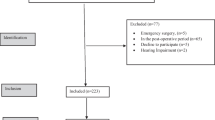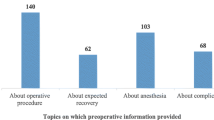Abstract
There is an increasing interest in the effects of preoperative anxiety on the course and outcomes of surgical treatments and also in the studies about the anxiety-decreasing interventions. The present study aims to identify the relationship between the preoperative anxiety level of the individuals prior to aesthetic surgery operations such as nose, ear, eyelid, and mammoplasty and religious rituals such as performing prayers, fasting, and going to pilgrimage. The frequency of performing the religious rituals was identified through a questionnaire. The questionnaire included questions about the religious rituals such as performing prayers, going to a pilgrimage, and fasting as well as questions about sociodemographic features such as gender, age, and education level of the patients. Preoperative anxiety level was measured using the “Anxiety Specific to Surgery Questionnaire.” The nonparametric Mann–Whitney U test was used for the scale score comparisons of the two independent groups. The scale score comparisons of more than two groups were performed using the Kruskal–Wallis test. The relationships between age and scale scores were analyzed using the Spearman’s correlation coefficient. The study involved 117 patients who were planned to undergo an aesthetic surgery operation. The scale scores were significantly different according to the pilgrimage groups (p = 0.004). The scale scores were significantly different according to the level of fasting (p = 0.022). No significant differences were found between the scales scores of the groups who reported the frequency of performing prayer as never, sometimes or five times (p = 0.515). In conclusion, the present study found that Muslim people who performed religious rituals more often experienced less preoperative anxiety levels in plastic surgeries, which indicates that the belief level is an effective factor in preoperative anxiety levels. The findings of the present study indicate that patients’ beliefs and worship practices should be taken into consideration by doctors, operating room personnel, and even all health workers in order to decrease the anxiety levels of patients who will undergo surgery.


Similar content being viewed by others
References
Al-Ghabeesh, S. H., Alshraifeen, A. A., Saifan, A. R., Bashayreh, I. H., Alnuaimi, K. M., & Masalha, H. A. (2018). Spirituality in the lives of patients with end-stage renal disease: A systematic review. Journal of Religion and Health,57(6), 2461–2477.
Aliche, J. C., Ifeagwazi, C. M., Chukwuorji, J. C., & Eze, J. E. (2018). Roles of religious commitment, emotion regulation and social support in preoperative anxiety. Journal of Religion and Health. https://doi.org/10.1007/s10943-018-0693-0.
Atiyeh, B. S., Kadry, M., Hayek, S. N., & Musharafieh, R. S. (2008). Aesthetic surgery and religion: Islamic law perspective. Aesthetic Plastic Surgery,32, 1–10.
Babamohamadi, H., Sotodehasl, N., Koenig, H. G., Jahani, C., & Ghorbani, R. (2015). The effect of Holy Qur’an recitation on anxiety in hemodialysis patients: A randomized clinical trial. Journal of Religion and Health,54(5), 1921–1930.
Badanta-Romero, B., de Diego-Cordero, R., & Rivilla-García, E. (2018). Influence of religious and spiritual elements on adherence to pharmacological treatment. Journal of Religion and Health,57(5), 1905–1917.
Bay, P. S., Beckman, D., Trippi, J., Gunderman, R., & Terry, C. (2008). The effect of pastoral care services on anxiety, depression, hope, religious coping, and religious problem solving styles: A randomized controlled study. Journal of Religion and Health,47(1), 57–69.
Clark, E. M., Williams, B. R., Huang, J., Roth, D. L., & Holt, C. L. (2018). A longitudinal study of religiosity, spiritual health locus of control, and health behaviors in a national sample of African Americans. Journal of Religion and Health,57(6), 2258–2278.
Coştu, Yakup. (2009). Approach to religion by the normative and popular: “A test on the religious orientation scale”. Journal of Divinity Faculty of Hitit University,8(15), 119–139.
Demir, E. (2019). The evolution of spirituality, religion and health publications: Yesterday, today and tomorrow. Journal of Religion and Health,58(1), 1–13.
Demir, E., & Yıldırım, E. (2019). The effect of religious belief on the attitudes of pregnant’s toward the fetal health. Journal of Religion and Health. https://doi.org/10.1007/s10943-019-00818-6.
Drumhiller, K., Nanín, J. E., Gaul, Z., & Sutton, M. Y. (2018). The influence of religion and spirituality on HIV prevention among Black and Latino Men who have sex with men, New York City. Journal of Religion and Health,57, 1931–1947.
Farag, P., & Behzadi, A. (2018). Investigating the relationship between religiosity and psychological distress among surgical inpatients: A pilot study. Journal of Religion and Health,57, 291.
Fındık, Ü. Y., & Topçu, S. Y. (2012). Effect of the way of surgery on preoperative anxiety. Hacettepe University Faculty of Health Sciences Journal,19, 22–33.
Kalkhoran, M. A., & Karimollahi, M. (2007). Religiousness and preoperative anxiety: A correlational study. Annals of General Psychiatry,6(1), 17.
Karanci, A. N., & Dirik, G. (2003). Predictors of pre and postoperative anxiety ın emergency surgery patients. Journal of Psychosomatic Research,55, 363–369.
Koenig, H. G., McCullough, M. E., & Larson, D. B. (2001). Handbook of religion and health. New York: Oxford University Press.
Muslu, Ü., & Demir, E. (2019). The effect of religious beliefs on the attitude of aesthetic surgery operation in Islam. Journal of Religion and Health. https://doi.org/10.1007/s10943-019-00767-0.
van Randwijk, C. B., Opsahl, T., Hvidt, E. A., Kørup, A. K., Bjerrum, L., Thomsen, K. F., et al. (2019). Characteristics of religious and spiritual beliefs of danish physicians: And likelihood of addressing religious and spiritual issues with patients. Journal of Religion and Health,58(1), 333–342.
Author information
Authors and Affiliations
Corresponding author
Ethics declarations
Conflict of interest
The authors declare that they have no conflict of interests.
Ethical Approval
All procedures performed in studies involving human participants were in accordance with the ethical standards of the institutional and/or national research committee and with the 1964 Helsinki declaration and its later amendments or comparable ethical standards.
Informed Consent
Informed consent was obtained from all individual participants included in the study.
Additional information
Publisher's Note
Springer Nature remains neutral with regard to jurisdictional claims in published maps and institutional affiliations.
Rights and permissions
About this article
Cite this article
Muslu, Ü., Demir, E. Investigation of the Relationship Between Anxiety Levels of Patients Before Plastic Surgery Operation and Worship Practices in Muslims. J Relig Health 59, 535–543 (2020). https://doi.org/10.1007/s10943-019-00846-2
Published:
Issue Date:
DOI: https://doi.org/10.1007/s10943-019-00846-2




